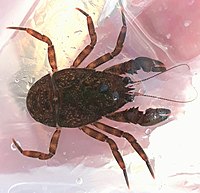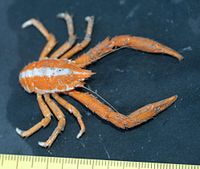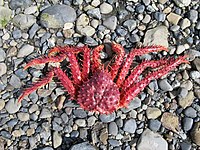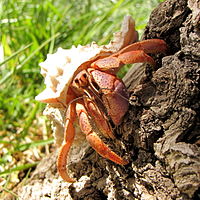Superregnum: Eukaryota
Cladus: Unikonta
Cladus: Opisthokonta
Cladus: Holozoa
Regnum: Animalia
Subregnum: Eumetazoa
Cladus: Bilateria
Cladus: Nephrozoa
Cladus: Protostomia
Cladus: Ecdysozoa
Cladus: Panarthropoda
Phylum: Arthropoda
Subphylum: Crustacea
Superclassis: Multicrustacea
Classis: Malacostraca
Subclassis: Eumalacostraca
Superordo: Eucarida
Ordo: Decapoda
Subordo: Pleocyemata
Infraordo: Anomura
Superfamiliae: Aegloidea - Chirostyloidea - Galatheoidea - Hippoidea - Lithodoidea - Lomisoidea - Paguroidea - †Gastrodoroidea
References
Castro, P. 2011: Catalog of the anomuran and brachyuran crabs (Crustacea: Decapoda: Anomura, Brachyura) of the Hawaiian Islands. Zootaxa, 2947: 1–154. Preview
El-Wakeil, K.F.A. et al. 2009: Hermit crabs (Crustacea: Decapoda: Anomura) inhabiting the intertidal and shallow subtidal region of Red Sea coast of Egypt. Zootaxa, 2213: 57–63. Abstract & excerpt
Forest, J.; Laurent, M., de S.; McLaughlin, P.A.; Lemaitre, R. 2000: The marine fauna of New Zealand: Paguridea (Decapoda: Anomura) exclusive of the Lithodidae. NIWA biodiversity memoir, (114).
McLay, C.L. 1988: Crabs of New Zealand. Brachyura and crab-like Anomura of New Zealand. Leigh laboratory bulletin, (22). University of Auckland Leigh Marine Laboratory, Auckland, New Zealand.
Webber, W.R. et al. 2010: [Chapter] EIGHT Phylum ARTHROPODA SUBPHYLUM CRUSTACEA shrimps, crabs, lobsters, barnacles, slaters, and kin. pp. 98–232 in Gordon, D.P. (ed.): New Zealand inventory of biodiversity. Volume 2. Kingdom Animalia. Chaetognatha, Ecdysozoa, ichnofossils. Canterbury University Press, Christchurch, New Zealand. ISBN 978-1-87725793-3
Vernacular names
中文: 异尾下目
Anomura (sometimes Anomala) is a group of decapod crustaceans, including hermit crabs and others. Although the names of many anomurans include the word crab, all true crabs are in the sister group to the Anomura, the Brachyura (the two groups together form the clade Meiura).[1]
Description
The name Anomura derives from an old classification in which reptant decapods were divided into Macrura (long-tailed), Brachyura (short-tailed) and Anomura (differently-tailed). The alternative name Anomala reflects the unusual variety of forms in this group; whereas all crabs share some obvious similarities, the various groups of anomurans are quite dissimilar.[2]
The group has been moulded by several instances of carcinisation – the development of a crab-like body form.[3] Thus, the king crabs (Lithodidae), porcelain crabs (Porcellanidae) and hairy stone crab (Lomisidae) are all separate instances of carcinisation.[3]
As decapods (meaning ten-legged), anomurans have ten pereiopods, but the last pair of these is reduced in size, and often hidden inside the gill chamber (under the carapace) to be used for cleaning the gills.[4][2] Since this arrangement is very rare in true crabs (for example, the small family Hexapodidae),[5] a "crab" with only eight visible pereiopods is generally an anomuran.[2]
Evolution
The infraorder Anomura belongs to the group Reptantia, which consists of the walking/crawling decapods (lobsters and crabs). There is wide acceptance from morphological and molecular data that Anomura and Brachyura (true crabs) are sister taxa, together making up the clade Meiura.[3] The cladogram below shows Anomura's placement within the larger order Decapoda, from analysis by Wolfe et al. (2019).[6]
| Decapoda |
|
||||||||||||||||||||||||||||||||||||||||||||||||||||||||||||||||||
Some of the internal relationships within Anomura can be shown in the cladogram below, which shows Hippidae as sister to Paguroidea, and resolves Parapaguridae outside of Paguroidea:[6]
| Anomura |
|
||||||||||||||||||||||||||||||||||||||||||||||||
Classification
The infraorder Anomura contained seven extant superfamilies:[7][8][9][10]
| Superfamily | Members | Families | Photo |
|---|---|---|---|
| Aegloidea | Aegla | Aeglidae |  Aegla sp. |
| Chirostyloidea | squat lobsters | Chirostylidae Eumunididae Kiwaidae |
 Eumunida picta |
| † Eocarcinoidea | † Eocarcinus † Platykotta |
† Eocarcinidae † Platykottidae |
|
| Galatheoidea | squat lobsters porcelain crabs |
Galatheidae Munididae Munidopsidae Porcellanidae † Retrorsichelidae |
 Munidopsis serricornis (Munidopsidae) |
| Hippoidea | mole crabs or sand crabs |
Albuneidae Blepharipodidae Hippidae |
 Blepharipoda occidentalis (Blepharipodidae) |
| Lithodoidea | king crabs | Hapalogastridae Lithodidae |
 Lithodes santolla (Lithodidae) |
| Lomisoidea | hairy stone crab | Lomisidae | |
| Paguroidea | hermit crabs coconut crab |
Coenobitidae Diogenidae Paguridae Parapaguridae Parapylochelidae Pylochelidae Pylojacquesidae |
 Coenobita clypeatus (Coenobitidae) |
The oldest fossil attributed to Anomura is Platykotta, from the Norian–Rhaetian (Late Triassic) Period in the United Arab Emirates.[8]
References
Gerhard Scholtz; Stefan Richter (1995). "Phylogenetic systematics of the reptantian Decapoda (Crustacea, Malacostraca)" (PDF). Zoological Journal of the Linnean Society. 113 (3): 289–328. doi:10.1111/j.1096-3642.1995.tb00936.x.
Gary Poore (2004). "Anomura – hermit crabs, porcelain crabs and squat lobsters". Marine Decapod Crustacea of Southern Australia: a Guide to Identification. CSIRO Publishing. pp. 215–287. ISBN 978-0-643-09925-8.
Shane T. Ahyong; Kareen E. Schnabel; Elizabeth W. Maas (2009). "Anomuran phylogeny: new insights from molecular data". In Joel W. Martin; Keith A. Crandall; Darryl L. Felder (eds.). Decapod Crustacean Phylogenetics. Crustacean issues. Vol. 18. CRC Press. pp. 399–414. doi:10.1201/9781420092592-c20. ISBN 978-1-4200-9258-5.
Jonas Keiler; Stefan Richter (2011). "Morphological diversity of setae on the grooming legs in Anomala (Decapoda: Reptantia) revealed by scanning electron microscopy". Zoologischer Anzeiger. 250 (4): 343–366. doi:10.1016/j.jcz.2011.04.004.
Carrie E. Schweitzer; Rodney M. Feldmann (2001). "Differentiation of the fossil Hexapodidae Miers, 1886 (Decapoda: Brachyura) from similar forms" (PDF). Journal of Paleontology. 75 (2): 330–345. doi:10.1666/0022-3360(2001)075<0330:DOTFHM>2.0.CO;2.
Wolfe, Joanna M.; Breinholt, Jesse W.; Crandall, Keith A.; Lemmon, Alan R.; Lemmon, Emily Moriarty; Timm, Laura E.; et al. (24 April 2019). "A phylogenomic framework, evolutionary timeline and genomic resources for comparative studies of decapod crustaceans". Proceedings of the Royal Society B. 286 (1901). doi:10.1098/rspb.2019.0079. PMC 6501934. PMID 31014217.
Sammy De Grave; N. Dean Pentcheff; Shane T. Ahyong; et al. (2009). "A classification of living and fossil genera of decapod crustaceans" (PDF). Raffles Bulletin of Zoology. Suppl. 21: 1–109.
Jérôme Chablais; Rodney M. Feldmann; Carrie E. Schweitzer (2011). "A new Triassic decapod, Platykotta akaina, from the Arabian shelf of the northern United Arab Emirates: earliest occurrence of the Anomura" (PDF). Paläontologische Zeitschrift. 85: 93–102. doi:10.1007/s12542-010-0080-y.
K. E. Schnabel; S. T. Ahyong; E. W. Maas (2011). "Galatheoidea are not monophyletic – molecular and morphological phylogeny of the squat lobsters (Decapoda: Anomura) with recognition of a new superfamily". Molecular Phylogenetics and Evolution. 58 (2): 157–168. doi:10.1016/j.ympev.2010.11.011. PMID 21095236.
WoRMS (2018). "Anomura". WoRMS. World Register of Marine Species. Retrieved 2018-09-28.
Retrieved from "http://en.wikipedia.org/"
All text is available under the terms of the GNU Free Documentation License

